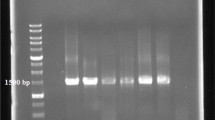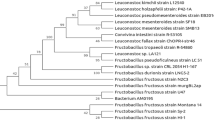Abstract
Purpose
Honey is a promising source of bacterial strains producing metabolites with antimicrobial activity. There is a great variety in the antimicrobial activity of honey from different areas of nature. Therefore, the aim of present study was to investigate the antibacterial activity of Iranian honey from different regions and to optimize the culture condition for the highly potent bacterial isolate.
Methods
Honey samples were collected from ten different regions of Iran and were screened for bacteriocin-producing bacteria. The best bacteriocin-producing strain was characterized and identified by 16S rDNA analysis. One-factor-at-a-time method was used for optimization of culture medium and the yield and time-course of bacteriocin production were compared in both shake flask and bio-reactor.
Results
The Bacillus subtilis SB1 that was isolated from Sabalan honey showed potent antibacterial activity with prominent thermal stability. The optimum medium for the bacteiocin production was a yeast extract-based medium. The optimum incubation temperature for bacteriocin production was 34 °C. Bacteriocin production was higher near neutral pH conditions than that produced at acidic or alkaline environment. The results of cell growth and bacteriocin assays revealed that the exponential phase of growth and antibacterial compounds production was started rapidly in bioreactor than flask.
Conclusions
Findings of this study supported the folkloric application of honey against some infectious diseases. B.subtilis SB1 that isolated from Sabalan honey was a potential source for bacteriocins-like compounds. Our studies suggested a simple buffered nitrogen-based medium for SB1 growth and bacteriocin activity in both shake flask and bioreactor.


Similar content being viewed by others
References
Kwakman PHS, Van den Akker JPC, Güçlü A, et al. Medical grade honey kills antibiotic resistant bacteria in vitro and eradicates skin colonization. Clin Infect Dis. 2008;46(11):1677–82. https://doi.org/10.1086/587892.
Mandal MD, Mandal S, Honey. Its medicinal property and antibacterial activity. Asian Pac J Trop Biomed. 2011;1(2):154–60. https://doi.org/10.1016/S2221-1691(11)60016-6.
Abd-El Aal A, El-Hadidy M, El-Mashad N, El-Sebaie A. Antimicrobial effect of bee honey in comparison to antibiotics on organisms isolated from infected burns . Ann Burns Fire Disasters. 2007;20(2):83–8.
Al-Waili NS. Investigating the antimicrobial activity of natural honey and its effects on the pathogenic bacterial infections of surgical wounds and conjunctiva. J Med Food. 2004;7(2):210–22. https://doi.org/10.1089/1096620041224139.
Ibarguren C, Raya RR, Apella MC, Audisio MC. Enterococcus faecium isolated from honey synthesized bacteriocin-like substances active against different Listeria monocytogenes strains. J Microbiol. 2010;48(1):44–52. https://doi.org/10.1007/s12275-009-0177-8.
Pajor M, Worobo RW, Milewski S, Szweda P. The antimicrobial potential of bacteria isolated from honey samples produced in the apiaries located in pomeranian voivodeship in Northern Poland. Int J Environ Res Public Health. 2018;15(9):1–14. https://doi.org/10.3390/ijerph15092002.
Ansari A, Aman A, Siddiqui NN, Iqbal S, Ali S. Bacteriocin. (BAC-IB17): screening, isolation and production from Bacillus subtilis KIBGE IB-17. Pak. J Pharm Sci. 2012;25(1):195–201.
Kim MH, Kong YJ, Baek H, Hyun HH. Optimization of culture conditions and medium composition for the production of micrococcin GO5 by Micrococcus sp. GO5. J Biotechnol. 2006;121(1):54–61. https://doi.org/10.1016/j.jbiotec.2005.06.022.
Snowdon JA, Cliverb D. Microorganisms in honey. Int J Food Microbiol. 1996;31(1–3):1–26. https://doi.org/10.1016/0168-1605(96)00970-1.
Gomes S, Dias LG, Moreira LL, Rodrigues P, Estevinho L. Physicochemical, microbiological and antimicrobial properties of commercial honeys from Portugal. Food Chem Toxicol. 2010;48(2):544–8. https://doi.org/10.1016/j.fct.2009.11.029.
Abriouel H, Franz CMAP, Omar N, Ben, Galvez A. Diversity and applications of Bacillus bacteriocins. FEMS Microbiol Rev. 2011;35(1):201–32. https://doi.org/10.1111/j.1574-6976.2010.00244.x.
Esawy MA, Ahmed EF, Helmy WA, Mansour NM, El-Senousy WM, El-Safty MM. Production of levansucrase from novel honey Bacillus subtilis isolates capable of producing antiviral levans. Carbohyd Polym. 2011;86(2):823–30. https://doi.org/10.1016/j.carbpol.2011.05.035.
Corsetti A, Settanni L, Sinderen D, Van, Felis GE, Dellaglio F, Gobbetti M. Lactobacillus rossii sp. nov., isolated from wheat sourdough. 2019;(2005):35–40. https://doi.org/10.1099/ijs.0.63075-0.
Batdorj B, Dalgalarrondo M, Choiset Y, et al. Purification and characterization of two bacteriocins produced by lactic acid bacteria isolated from Mongolian airag. J Appl Microbiol. 2006;101(4):837–48. https://doi.org/10.1111/j.1365-2672.2006.02966.x.
Van Reenen CA, Dicks LMT, Chikindas ML. Isolation, purification and partial characterization of plantaricin 423, a bacteriocin produced by Lactobacillus plantarum. J Appl Microbiol. 1998;84(6):1131–7. https://doi.org/10.1046/j.1365-2672.1998.00451.x.
Agbagwa OE, Rani SD, Halami PM. Antibacterial potential components of Bacillus species and antibiotics residues in branded and unbranded honey samples from Nigeria. Afr J Biotechnol. 2017;16(2):58–64. https://doi.org/10.5897/AJB2016.15714.
Lu Z, Guo W, Liu C. Isolation, identification and characterization of novel Bacillus subtilis. J Vet Med Sci. 2018;80(3):427–33. https://doi.org/10.1292/jvms.16-0572.
Weisburg WG, Barns SM, Pelletier DA, Lane DJ. 16S ribosomal DNA amplification for phylogenetic study. J Bacteriol. 1991;173(2):697–703. https://doi.org/10.1128/jb.173.2.697-703.1991.
Studier W. Stable expression clones and auto-induction for protein production in E. coli. Structural Genomics. 2013:17–32. https://doi.org/10.1007/978-1-62703-691-7_2.
Powell JE, Witthuhn RC, Todorov SD, Dicks LMT. Characterization of bacteriocin ST8KF produced by a kefir isolate Lactobacillus plantarum ST8KF. Int Dairy J. 2007;17(3):190–8. https://doi.org/10.1016/j.idairyj.2006.02.012.
Lee NK, Paik HD. Partial characterisation of lactocin NK24, a newly identified bacteriocin of Lactococcus lactis NK24 isolated from Jeot-gal. Food Microbiol. 2001;18(1):17–24. https://doi.org/10.1006/fmic.2000.0368.
Ivanova I, Kabadjova P, Pantev A, Danova S, Dousset X. Detection, purification and partial characterization of a novel bacteriocin substance produced by Lactococcus lactis subsp. lactis B14 isolated from boza-Bulgarian traditional cereal beverage. Biocatalisis. 2000;41:47–53.
Mojgani N, Vaccine R. Detection and characterization of a heat stable bacteriocin (Lactocin LC-09) produced by a clinical isolate of Lactobacilli. Med J Islam Acad Sci. 1999;12(3):67–71.
Nadu T, Nadu T, Nadu T. Optimization of bacteriocin production by Bacillus subtilis BMP01 isolated from Solanum trilobatum L. Int J Curr Microbiol App Sci. 2015;4(3):617–26.
Stein T. Bacillus subtilis antibiotics: Structures, syntheses and specific functions. Mol Microbiol. 2005;56(4):845–57. https://doi.org/10.1111/j.1365-2958.2005.04587.x.
Todorov SD, Dicks LMT. Effect of medium components on bacteriocin production by Lactobacillus plantarum strains ST23LD and ST341LD, isolated from spoiled olive brine. Microbiol Res. 2006;161(2):102–8. https://doi.org/10.1016/j.micres.2005.06.006.
Rhouma A, Jaouadi B, Rebai A, Nesme X. Optimization and biochemical characterization of a bacteriocin from a newly isolated Bacillus subtilis strain 14B for biocontrol of Agrobacterium spp. strains. Lett Appl Microbiol. 2009;48(2):253–60. https://doi.org/10.1111/j.1472-765X.2008.02524.x.
Kayalvizhi N, Gunasekaran P. Production and characterization of a low-molecular-weight bacteriocin from Bacillus licheniformis MKU3. Lett Appl Microbiol. 2008;47(6):600–7. https://doi.org/10.1111/j.1472-765X.2008.02473.x.
Todorov SD, Dicks LMT. Lactobacillus plantarum isolated from molasses produces bacteriocins active against Gram-negative bacteria. Enzym Microb Technol. 2005;36(2–3):318–26. https://doi.org/10.1016/j.enzmictec.2004.09.009.
Cheigh C, Choi H, Park H, et al. Influence of growth conditions on the production of a nisin-like bacteriocin by Lactococcus lactis subsp. lactis A164 isolated from kimchi. J Biotechnol. 2002;95(3):225–35. https://doi.org/10.1016/S0168-1656(02)00010-X.
Brito D, Fevereiro P, Delgado A, No´ e Arroyo L´opez F, Peres C, Garrido-Fern´andez A. Optimum bacteriocin production by Lactobacillus plantarum 17.2b requires absence of NaCl and apparently follows a mixed metabolite kinetics. J Biotechnol. 2007;130(2):193–201. https://doi.org/10.1016/j.jbiotec.2007.01.041.
Taheri P, Samadi N, Reza Ehsani M, Reza Khoshay M, Jamalifar H. An evaluation and partial characterization of a bacteriocin produced by lactococcus lactis subsp lactis ST1 isolated from goat milk. Braz J Microbiol. 2012;43(4):1452–62. https://doi.org/10.1590/S1517-83822012000400029.
Mitra S, Chakrabartty PK. Production of Nisin Z by Lactococcus lactis Isolated from Dahi. Appl Biochem Biotechnol. 2007;143(1):41–53. https://doi.org/10.1007/s12010-007-0032-5.
Onda T, Yanagida F, Tsuji M. Production and purification of a bacteriocin peptide produced by Lactococcus sp. strain GM005, isolated from Miso -paste. Int J Food Microbiol. 2003;87(1–2):153–9. https://doi.org/10.1016/S0168-1605(03)00063-1.
Bizani D, Brandelli A. Influence of media and temperature on bacteriocin production by Bacillus cereus 8A during batch cultivation. Appl Microbiol Biotechnol. 2004;65(2):158–62. https://doi.org/10.1007/s00253-004-1570-1.
Leal-Sánchez MV, Jiménez-Díaz R, Maldonado-Barragán A, Garrido-Fernández A, Ruiz-Barba JL. Optimization of bacteriocin production by batch fermentation of Lactobacillus plantarum LPCO10. Appl Environ Microbiol. 2002;68(9):4465–71. https://doi.org/10.1128/AEM.68.9.4465-4471.2002.
Author information
Authors and Affiliations
Corresponding author
Ethics declarations
Conflict of interest
The authors declare that they have no conflict of interest.
Additional information
Publisher’s note
Springer Nature remains neutral with regard to jurisdictional claims in published maps and institutional affiliations.
Rights and permissions
About this article
Cite this article
Khalili Samani, M., Noormohammadi, Z., Fazeli, M.R. et al. Bacteriocin activity of various iranian honey‐associated bacteria and development of a simple medium for enhanced bacteriocin activity. J Environ Health Sci Engineer 19, 427–435 (2021). https://doi.org/10.1007/s40201-021-00615-y
Received:
Accepted:
Published:
Issue Date:
DOI: https://doi.org/10.1007/s40201-021-00615-y




